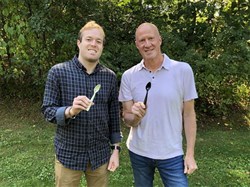VOL. 47 | NO. 3 | Friday, January 13, 2023
CES reveals innovations, from tractors to dog talk

Longtime consumer technology reporter Jamey Tucker provides his human-centric look at gadgets and gizmos called “What The Tech…?” online at whatthetech.tv and for television newscasts around the country. Tucker was in Las Vegas last week to cover the first full-blown CES (formerly known as the Consumer Electronics Show) in three years and had these observations for The Ledger.
-- Photograph ProvidedIf you’re a gadget lover at heart, hearing the letters CES strung together transports you to the biggest and baddest new technology around … the stuff you put in your house that can cost more than your house.
You also think of the household brand names and product types associated with tech – Sony, Panasonic, Amazon, Google, the major wireless carriers and car manufacturers. The ever-evolving future of driverless transportation was showcased during the show in Las Vegas last week, with The Indy Autonomous Challenge, a race between fully autonomous Formula One-style race cars at the Las Vegas Speedway.
Even iconic brands such as John Deere got involved in the CES universe this year, the show’s attempt at a “return to normal” after the COVID-spurred cancellation of 2021 and the reduced slate of attendees and presenting companies in 2022.
“Why should you care about farmers when they represent less than 2% of the U.S. population?” John May, CEO of John Deere, said at a keynote, preempting questions about why the longtime implement manufacturer was so visible at the show. “You will not find two industries that have a larger impact on our world and all of us than agriculture and construction.”

The Father-son team of Cameron and Ken Davidov, developers of SpoonTEK.
-- Photograph ProvidedAnd you couldn’t take two steps within any of CES’ primary venues – Las Vegas Convention Center, Mandalay Bay, and The Venetian Expo Center – without hearing, seeing or feeling the word “metaverse.” Even if most people, from the industry professionals to the professionally curious, couldn’t tell you exactly what the “metaverse” is much less what it will become.
(For the record, it’s defined as “a virtual-reality space in which users can interact with a computer-generated environment and other users.”)
But much of CES’ charm and connection with consumers can be found away from the big-dollar booths, highlighting smaller companies with unique products designed to solve problems the likes of which you might not have pondered.
For example: “How can I better communicate with my pet?”
Innovation in multiple forms
FluentPet Connect, which was named as a winner of one of the show’s Innovation Awards, is a device that trains dogs and cats to communicate with their owners using human words.
Developer Leo Trottier said panels or tiles you place on the floor have buttons that can be programmed for certain words you want to teach your pet.
“Each of these buttons, when you press it, a word comes out of the speaker,” he explained. “Over time, they’ll learn how to press those buttons to ask for what they want.”
The function that really caught the show organizers’ imaginations was the ability for pets to text owners through FluentPet Connect when they’re not at home. Trottier says dogs have even started putting sentences together using multiple panels. “I’ve got to say whenever your dog says ‘I love you,’ it’s totally something else.”
Another of the 2023 Innovation Award winners was the Motion Pillow, from Korean manufacturer 10minds Co., Ltd. The Motion Pillow is a sleep system for snorers and people who sleep with them: a pillow and a bedside device that listens to a person sleeping.

CES 2023 Innovation Award-winning FluentPet Connect helps to bridge the communication gap between pets and their humans, with animals learning to tap buttons for simple words and phrases.
-- Photograph Provided“Once it hears you begin to snore, it finds where your head is on the pillow and it begins to move you gently,” says Brent Chappell of Motion Pillow. The pillow itself has no electronics inside; instead, air bags within the memory foam inflate to roll your head enough to change positions.
“Your airway reopens. You stop snoring, the pillow deactivates and you keep on sleeping,” Chappell says. The Motion Pillow is expected to be on sale in the U.S. later this year.
Of some 3,200 exhibitors at this year’s CES, several hundred were companies in the digital health space.
One of the more buzzed-about offerings comes from Neutrogena, which partnered with 3D-printed dietary supplements maker Nourished, to create personalized skin care gummy vitamins with a 3D printer.
The customer gets a digital face scan from Neutrogena to assess that person’s skin type. Once that information is gathered, the company’s 3D printer begins creating gummy vitamins personalized to one’s skin.
“They have 7 different layers of ingredients that are scientifically backed and are selected by our Neutrogena scientists,” says Desiree Dowe from Neutrogena. “They are freshly made to order and delivered to your door.”
Small companies, big ideas
An annual crowd favorite is a section at the Venetian Expo Center set aside for startups and inventors called Eureka Park.
These are typically smaller products but with providing real-world solutions, however esoteric they may be.
For example, Taste Boosters is a New York-based startup that presented three of its products at CES this year, including SpoonTEK, a taste-enhancing spoon.
“As you’re eating, it will light up,” says developer Ken Davidov of the gadget, which went through a successful Indiegogo campaign in 2020 and is now available for sale online. “That excites the taste buds on your tongue and enhances sweet and salty and suppresses sour.”
Another smart gadget, Heat It, is already on the European market. It uses heat to neutralize pain from bee stings and bug bites. Heat It attaches to a smartphone’s power port to neutralize the venom going into your skin by pressing it directly on the sting and heating the area for 30 seconds.
“Heat is the most amazing bug bite healer there is,” says spokesperson John Pohl.
“That process of heating it and it’s 124 degrees Fahrenheit; you feel it but it’s not painful, that heating process stops the release of the histamines which stops the itch or the sting.” Heat It launches soon in the United States.
A Canadian startup has come up with smart glasses for people with vision loss. Seleste smart glasses have a camera and microphone. Someone with vision loss can look at something, like a menu, and a volunteer somewhere in the world connects to the wearer and reads it for them. The glasses’ bone conduction speaker technology allows the wearer to hear the feedback privately.
Some of the products in Eureka Park, and elsewhere throughout CES, will never be sold in the United States. The inventors and startups come here to raise funding or in many cases, they’ll sell their technology to larger companies in the world, making this special corner of CES a very fun place to be.
Edited by Lucas Hendrickson